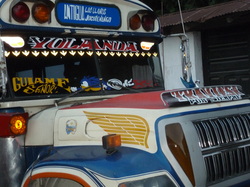

The library is small with many tables and a scattering of books. When Mily asks for a history of Sumpango we receive a sheaf of stapled pages. We learn that 92% of the population in Sumpango are Kaqchikel Mayans. In Mayan, Sumpango is known as the “stomach of the hills” and indeed the carrots and cabbages in the market were the largest I have ever seen. There are a only a few paragraphs about los barriletes gigantes, which unlike many Mayan traditions is a more recent addition, added 120 years old and specific to only two Mayan pueblos, Sumpango and Santiago, Sacatepequez. There is little additional information about the origins of the kite festival in the library.
I am eager to meet some of the makers of the giant kites and hopefully to see the kitemaking first hand. We return to the municipal building for more information. The man we ask says, “just a minute please,” and brings us two chairs to sit in before he hurries off. He returns quickly with a young man, Oskar Yuk, who beckons us to follow him to his own tiny office.
“We only work on the kites at night and sometimes on weekends, so you can not see our kite now, though we are working on it as it takes many months to complete. But I have here on this computer pictures of our kites from before.”
I am immediately enchanted by the photographs. The kites resemble large paintings, like murals. It is hard to believe that they are not drawn or painted but are instead composed of thousands of pieces of “China paper,” cut so as to create the designs in a multitude of colors, then glued onto the base, an enormous circle of paper.
Oskar tells us that each kite has a spiritual and philosophical meaning connected to Mayan cosmology, the earth, the stars and also themes of the future. One kite features a large figure of a women, the mountains and stars and a spiral of Mayan glyps. Another shows the shadow of a famous Guatemalan poet and a stretching tree. Oskar tells us that achieving the effect of a shadowed figure is their special technique and again it seems incredible that the figure is actually made of paper. Each kite is nearly 50 feet in diameter. And like the smaller flying kites, there are messages to the ancestors which will be carried by the wind on this special day when the spirits of those who walked before are closer to the realm of the living.
There are several groups in addition to Oskar’s making the giant kites. These enormous t kites are not flown, but are mounted on huge bamboo frames and pulled upright for the festival where they are part of a design competition. But in this process of mounting and raising the kite upright is the same challenge that besets those who will fly smaller kites – the wind and the weather. A enormous kite can be torn by the wind in the process of moving it from horizontal to vertical, destroying months of work. Fortunately this has not happened to Oskar’s group in the four years they have come together to make the kites.
Oskar’s group has about 20 members, including his brothers, his niece and their friends. Oskar tells us that the group collectively decides on the design. And they not only work on weekends and at night, but they work all night long on many nights, cutting and gluing and creating the intricate motifs of the kite from the thin, colored papers. Indeed there were amusing photos of group members who had fallen asleep where they were working, a bucket of glue beside them!
Looking at the photos, I could not help but be moved by the sheer beauty of the kites and the incredible devotion of the kitemakers. Much of the money for their creation is raised and donated by the kitemakers themselves in honor of this creative and meaningful tradition. The actual kites will be seen for only a day on November 1 and then burned.
Oskar invited us to return on a day later in September to watch them work, which we happily agreed to do. Mily and I visited the La Iglesia de San Augustin Obisbo where we paused to take in the vista of the mountains surrounding Sumpango and the women below with their bundles of food wrapped in woven cloth,es. Inside la iglesia, a sweet shaded quiet, statues of virgins and the Christ child, and lit votive candles with their flickering prayers.


 RSS Feed
RSS Feed

